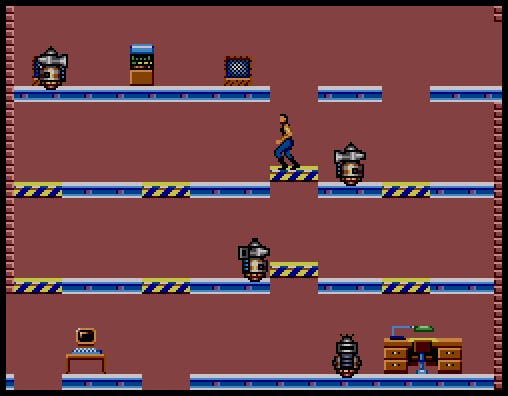Retrospective: Impossible Mission
Stay a while.
A rarity for videogame nasties, they were genuinely intimidating, too, a series of different AI behaviours meaning that sometimes they would patrol back and forth along set paths, while sometimes they would burst into life as you got close, zipping after you far faster than you could run. Worst of all, sometimes they would simply sit and watch you, staring malignantly like large metal frogs.
At the time, their predictable unpredictability was enough to convince me that they were actually aware of my presence, and that they were really thinking about things. And it's probably best not to get into the sheer screaming horror of the weird black ball that floats after you in certain levels. Back then, I didn't realise that it was a pinch from Rover in The Prisoner, but I sensed its malevolence all the same as it hovered towards me: a deadly over-sized Malteser crafted from bile, battery acid and five other different kinds of poison.
None of this was helped by the fact that, true to its name, Impossible Mission is not a particularly easy game. The player is given six hours to root through dozens of different rooms, searching for that nine-letter password, but you're docked 10 minutes each time you die, and two minutes each time you phone a friend for help on your pocket computer. And that's it: when your time is finally up, the world shakes itself apart in a series of brisk Doomsday explosions, and you're left with nothing but blackness and the sharp synthesised crackle of Atombender's laughter.
There are so many opportunities to die, too, either by touching a robot - touching in the literal, rather than the Hallmark sense: robots were a tough crowd even then - getting zapped by lasers, or plummeting to your death with a horrible scream.
Seeing as your agent is the most graceful of early computer game protagonists, it's initially quite a shock to see him disintegrated, or lose his footing and stumble into oblivion. It's clear that he probably wouldn't have done that if he was truly in control: it's clear that, actually, it was all your fault.

Nothing's quite as terrifying as the unknown, of course, and for me, the unknown was Impossible Mission's endgame, once you'd finally pulled Atombender's password together - no easy task, as the puzzle pieces could be flipped and rotated in dozens of different ways - before heading through the bright blue doorway that lead to the doctor's inner chambers for the big confrontation.
I never got that far, actually - I don't think I ever got more than half of the letters of a password, either. Time passed, and many years later I gave in and checked the game's finale out on YouTube. I won't spoil it for you, other than to say that it's nice to see Norman Tebbit was crafting a career outside of politics even then, but I certainly spoiled it for myself.
The excitement about what lay behind that final door had been brewing for the best part of two decades: unless Impossible Mission concluded in an emotional reunion with a choice selection of my own dead relatives (unlikely, given the C64's processing power) it was always going to disappoint.
Playing the game again on Wii Virtual Console, it's easy to appreciate its finer qualities, but I don't feel that same childish terror any more. It makes sense, really: I'm ostensibly a grown-up now, which means I'm meant to fear deadly robots only on special occasions. Perhaps if Impossible Mission focused on negative equity, Multi-Drug-Resistant Tuberculosis or accidentally getting in trouble with the tax people, it would be more effective.
There's something else beyond the waning appeal of the subject matter, though. Games are an imaginative business, in so much as, to really work, they require imagination from their players as well as their designers. I've probably lost a bit of that special power to lose myself in fantasy worlds (my third and fifth wives would disagree with this, however).
That's why I can enjoy the artistry, why I can admire the fact that each of the game's rooms is a smart little spatial puzzle when you take into account lift placement, platforms, and robot behaviours, and why I can marvel over the fact that Caswell himself left game design behind to carve out a career as a poet, but the results don't frighten me the way they used to do.
I miss that: the thrill of exploring something fascinating but scary. Instead, I load Impossible Mission up and find myself dragged towards the tyranny of plausibility rather than the simple pleasures of the fantastic. I wonder, "How did I get in?" when I should be asking, "How will I get out again?"
